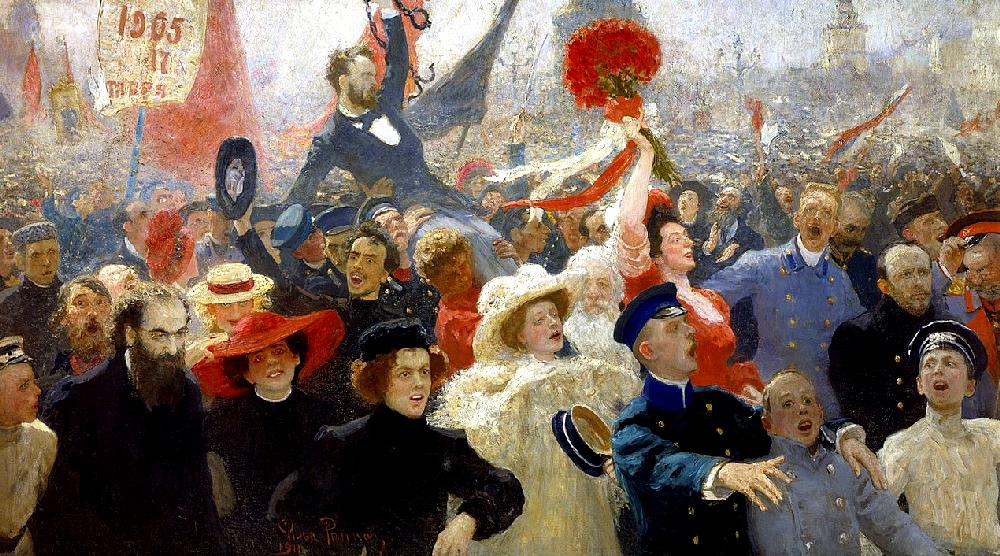
Russian Revolution of 1905

Figure 1.--Ilya Repin, the most important Russian artist of his generation, painted this work -- Demonstration of 19th October'. (October 30 on the Gregoruan calebar.) It depicrs the joy in Perograd/St. Petersburg when Tsar Nicholas II apprved "The Manifesto on the Improvement of the State Order" (Манифест об усовершенствовании государственного порядка). It was a step toward limiting absolutism. It led to Russia's first Constitution (1906). Nicholas was opposed to any limits on his absolutist authority. He finally acceed to the emploring of Grand Duke Nicholas and Count Sergei Witte. He had been Minister of Finance (1892–1903) and highly respected by Nichholas. He would be the first constitutional prime minister of Russian (1905–06). Nicholas only acceded because of the depth of the Revolution. Nicholas wanted to head a military dictatorship, but Grand Duke Nicholas threatened to shoot himself. The document became known as the October Manifesto. It offered basic civil rights and an elected parliament called the Duma, which would have to approve all future laws. The Manifesto was proclaimed in churches throughout the Empire.
|
|
The War with Japan (1904-05) was a major factor in bringing about the Russian Revolution of 1905. The War had a range of consequences. One was inflation which led to increases in the price of food and other goods (1904). Poorly paid Russian workers were barely able to afford essentials before inflation drove up prices. Inflation rose so rapidly that workers found their wages could no longer pay for the food needed by their families. Workers led by the new Assembly of Russian Workers (SRW) demanded wage increases. Management at the Putilov Iron Works fired four ARW members. ARW leader Father Gapon began to organize industrial action. It was the first effective industrial strike in Russia. Over 110,000 workers in Petrograd (St. Petersburg) went out on strike. Father Gapon deciding it was pointless to work with management which refused to deal with him, made a personal appeal to Tsar Nicholas. He composed a petition describing the workers' sufferings and listing their demands. Father Gapon called for a reduction in the working day to 8 hours which was becoming standard in Europe. Gapon also wanted an increase in wages, improved working conditions, and an end to the War with Japan. The petition was carried by a peaceful procession of workers to the Winter Palace. There the workers were attacked by the police and the mounted Cossacks. The result was more than 100 workers killed and about 300 wounded. This became known as Bloody Sunday in Russian history. The violent response of the Tsarist establshment launched the Revolution of 1905. Workers in other industrial cities went out on strike. The Revolution was not limited to workers. University students also went out on strike to support the workers. The universities had to close down. Students complained of the lack of civil liberties. There was considerable sympathy for the workers among the middle class, including lawyers, doctors, engineers, and other middle-class workers. Middle class organizers established the Union of Unions and demanded that the Tsar establish a constituent assembly. The support of the middle class was an ominous development for the Tsar. Even more important was the beginning of a crack in the military which kept the Tsar in power. Discipline in the military was strict and conditioins for the ordinary soldier and sailor were harsh. Sailors on the battleship Potemkin at Petrograd protested about the serving of rotten meat (June 1905). The captain ordered men he identified as the ringleaders to be sumarily shot. The firing-squad, however, refused to carry out the order. The crew then threw the captain and his officers overboard. The Potemkin Mutiny began to spread to other navy and army units. The industrial strike continued to spread. There was disorder in the countryside, this did not prove a threat to the regime. The peasantry was not as politically concious as the urban proleterit. The crucial railwaymen went on strike (October 1905). This brought the Russian industrial economy to a stop. Leon Trotsky and other Mensheviks (Socialists) established the Petrograd Soviet which would play a major role in Russian history. This set a precedent and more than 50 of these soviets were organized in the major cities throughout Russia. The Revolution shook the Tsarist Empire to the core. Tsar Nicholas was forced to issue the October Mnifesto (figure 1). He pledged to
grant a constitution which provided for a Duma or parliament. The Tsar was back in control (1907). The Tsarist state was, however, irevocably weakened.
CIH

Navigate the CIH World War I Pages:
[Return to Main Russian Revolution page]
[Return to Main Soviet communism page]
[Return to Main specific war and crisis page]
[Aftermath]
[Alliances]
[Animals]
[Armistace]
[Biographies]
[Causes]
[Campaigns]
[Casualties]
[Children]
[Countries]
[Declaration of war]
[Deciding factors]
-------[Diplomacy]
[Economics]
-------[Geo-political crisis]
[Home front]
[Intelligence]
[Military forces]
[Neutrality]
[Pacifism]
[People]
[Peace treaties]
[Propaganda]
[POWs]
[Russian Revolution]
[Terrorism]
[Trench warfare]
------[Technology]
[Weaponry]
[Bibliographies]
[Contributions]
[FAQs]
[Images]
[Links]
[Registration]
[Tools]
[Return to Main World War I page]
[Return to Main war essay page]
[Return to CIH Home page]
Created: 1:05 PM 7/27/2018
Last updated: 1:05 PM 7/27/2018



